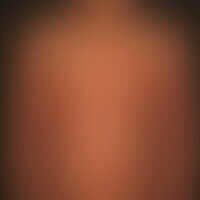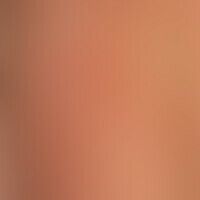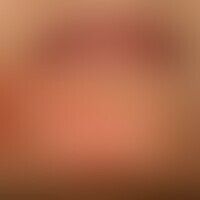Image diagnoses for "Plaque (raised surface > 1cm)", "red"
423 results with 1872 images
Results forPlaque (raised surface > 1cm)red
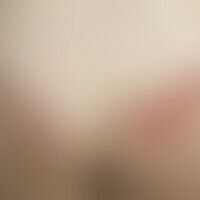
Contact dermatitis toxic L24.-
contact dermatitis toxic: 41-year-old female patient who noticed these painful striated red plaques after accidental contact with a corrosive fluid. the configuration of the efflorescences is evidence of an exogenous mechanism. the "unphysiological" stripe pattern completely excludes endogenous triggering.

Psoriasis (Übersicht) L40.-
Psoriais pustulosa generalisata: pustular exanthema that develops within a few weeks in patients with known psoriasis; the figure shows a state already in the process of healing with a racy flake detachment

Nummular dermatitis L30.0
Nummular Dermatitis: General view: For about 6-7 years persistent, strongly itching, solitary or confluent, coin-sized, infiltrated papules and plaques on the back of a 75-year-old female patient; in some cases small, dot-shaped, white, disseminated, atrophic scars are visible.

Hypertrophic Lichen planus L43.81
Lichen planus verrucosus. 1 year old, constantly itchy, blurred, firm plaque with a wart-like surface structure. The clinical findings are to be distinguished from those of a Lichen simplex chronicus (Vidal ).
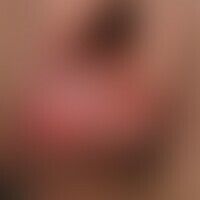
Balanitis plasmacellularis N48.1
Balanoposthitis plasmacellularis. 2 years (!) of varying degrees of persistent, burning and itching, sharply limited redness and erosions of the glans penis and prepuce in a 60-year-old patient, following preputial adhesions and frenuloplasty.
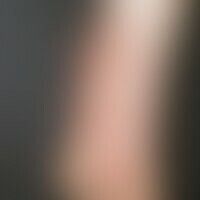
Infant haemangioma (overview) D18.01
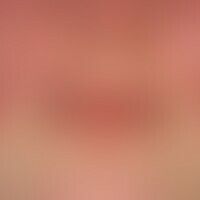
Lupus erythematosus systemic M32.9
Systemic lupus erythematosus: Pronounced findings with bilateral, symmetrical, flat plaques; flat scarring.
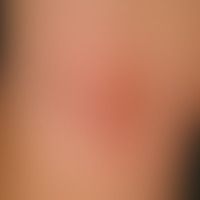
Atopic dermatitis (overview) L20.-
flexural atopic eczema. skin changes in an 18-year-old girl with intermittent course since the age of 4 years. positive FA; EA: pollinosis known. in the area of the hollow of the knee blurred, reddened, little scaly, moderately itchy plaques. skin field coarsened (lichenification). classic finding of flexural eczema.

Tungiasis B88.1
Tungiasis: Unusual extensive skin finding 4 weeks after bathing holiday in south-east asia in a 34-year-old woman. first itchy nodules 2-3 days after visiting the beach. continuous increase of clinical symptoms accompanied by severe itching. extensive finding of severely itching, disseminated, streaked papules on the back, both shoulders and the extensor sides of the arms (accidental contact with the surface of the ground).

Eyelid dermatitis (overview) H01.11
Atopic eyelid dermatitis: scaly and itchy dermatitis which is blurredly limited to all eyelids. seasonal course. known atopic disposition with type I sensitization (early blooming and grass pollen). eyelid cosmetics are not tolerated.
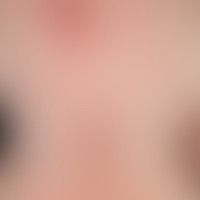
Pemphigus erythematosus L10.4
Pemphigus erythematosus: since about 1 year recurrent, symmetrical, red, rough plaques with coarse lamellar scales and crusts, localized in the seborrheic areas; little itching.
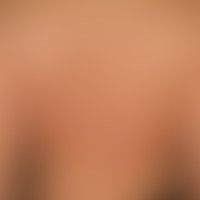
Psoriasis erythema anulare centrifugum-like L40.8
Psoriasis erythema anulare centrifugum-like: Chronic, intermittent, anular psoriasis with sharply defined prominent edges; round, scaly, crusty, isolated pustules.

Granuloma anulare erythematous L92.0
Granuloma of anular erythematous type. Red-brown plaque with little induration and marked central atrophy. Slow centrifugal growth lasting for months.
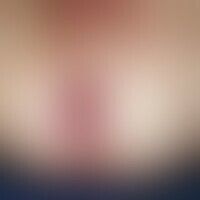
Acuminate condyloma A63.0
Condylomata acuminata in an infant; perianal, scrotal and inguinal small, pointy-headed, reddish, soft, rough papules.
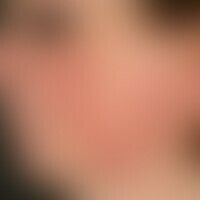
Sweet syndrome L98.2
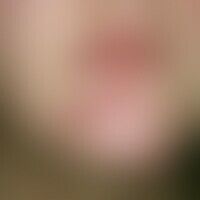
Lupus erythematodes chronicus discoides L93.0
Lupus erythematodes chronicus discoides. sharply defined, reddish, disc-shaped, partly scaly plaques with follicular hyperkeratosis and central atrophy; partly hypopigmentation or hyperpigmentation. chronic course. photosensitivity.
